PONTIAC FIERO 1988 Service Repair Manual
Manufacturer: PONTIAC, Model Year: 1988, Model line: FIERO, Model: PONTIAC FIERO 1988Pages: 1825, PDF Size: 99.44 MB
Page 851 of 1825
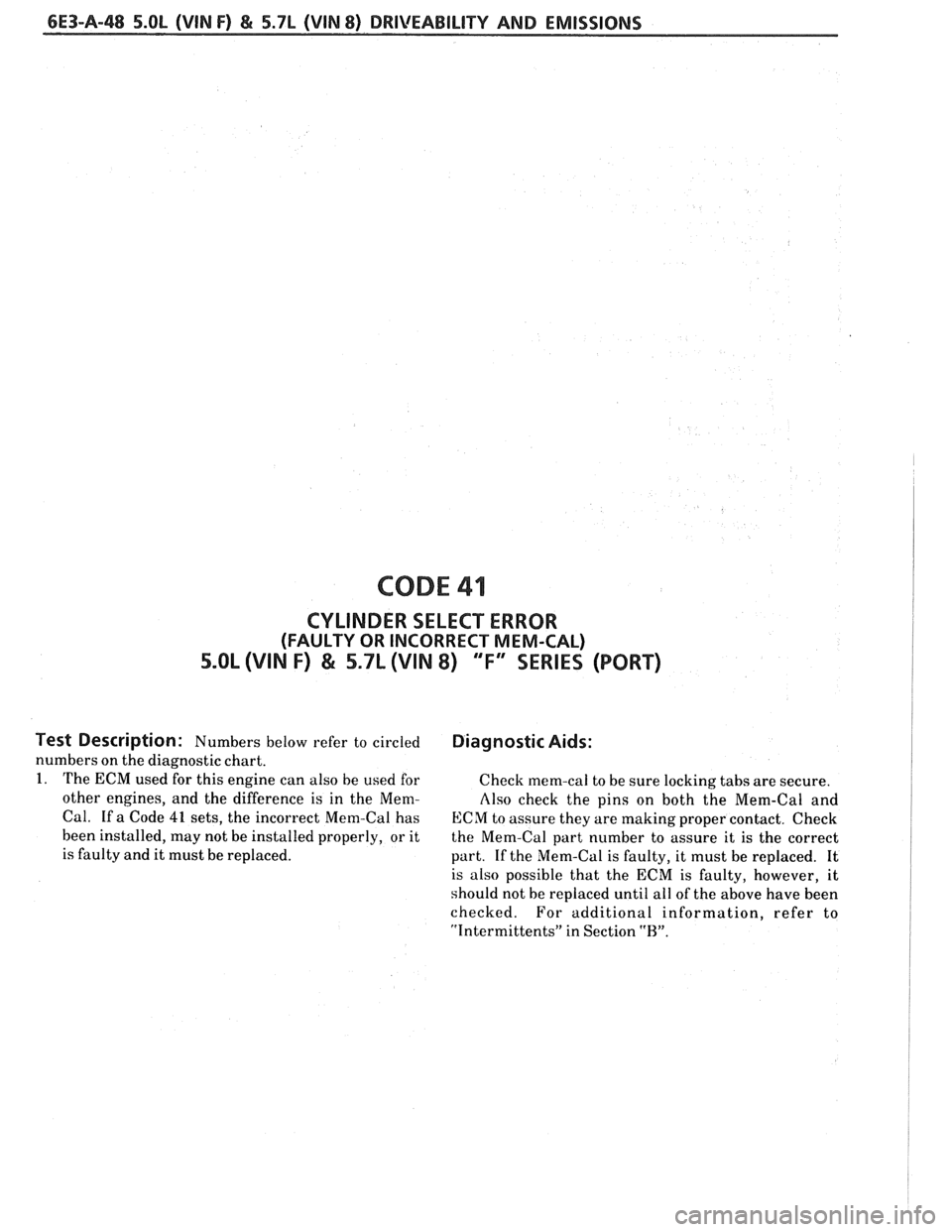
6E3-A-48 5.OL (VIN F) & 5.7L (VIN 8) DRIVEABILITY AND EMISSIONS
CODE 41
CYLINDER SELECT ERROR
(FAULTY OR INCORRECT MEM-CAL)
5.OL (VIN F) & 5.7L (VIN 8) "F" SERIES (PORT)
Test Description: Numbers below refer to circled Diagnostic Aids:
numbers on the diagnostic chart.
1. The ECM used for this engine can also be used for
Check mem-cal to be sure locking tabs are secure.
other engines, and the difference is in the Mem-
Also check the pins on both the Mem-Cal and
Cal. If a Code 41 sets, the incorrect Mem-Cal has
ECM to assure they are making proper contact. Check
been installed, may not be installed properly, or it
the Mem-Cal part number to assure it is the correct
is faulty and it must be replaced.
part. If the Mem-Cal is faulty, it must be replaced. It
is also possible that the ECM is faulty, however, it
should not be replaced until all of the above have been
checked. For additional information, refer to
"Intermittents" in Section
"H".
Page 852 of 1825

DRIVEABILITY AND EMISSIONS 5.OL (VIN F) & 5.7L (\/IN 8) 6E3-A-49
Page 853 of 1825
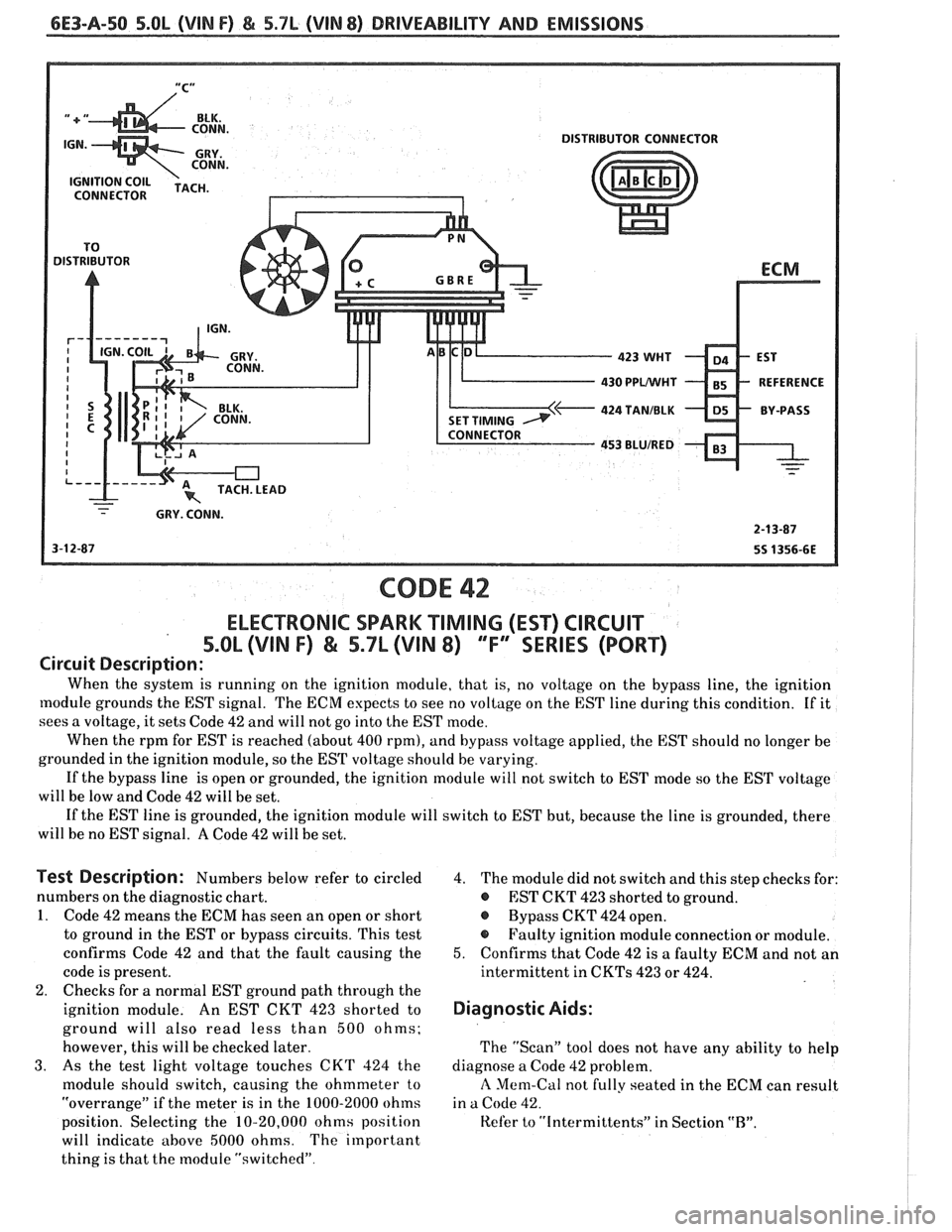
6E3-A-50 5.OL (VIN F) & 5.7L (VIN 8) DRI\/EABILITY AND EMISSIONS
430 PPUWHT
424 TANIBLK
CODE 42
ELECTRONIC SPARK "TIMING (EST) CIRCUIT
5.011, (VIN F) & 5.7L (VIN 8) ""FYESERIES (PORT)
Circuit Description:
When the system is running on the ignition module, that is, no voltage on the bypass line, the ignition
[nodule grounds the EST signal. The ECM expects to see no voltage on the EST line during this condition. If it
sees a voltage, it sets Code
42 and will not go into the EST mode.
When the rpm for EST is reached (about
400 rpm), and bypass voltage applied, the EST should no longer be
grounded in the ignition module, so the EST voltage should be varying.
If the bypass line is open or grounded, the ignition module will not switch to EST mode so the EST voltage
will be low and Code
42 will be set.
If the EST line is grounded, the ignition module will switch to EST but, because the line is grounded, there
will be no EST signal.
A Code 42 will be set.
Test Description: Numbers below refer to circled
numbers on the diagnostic chart.
1. Code 42 means the ECM has seen an open or short
to ground in the EST or bypass circuits. This test
confirms Code
42 and that the fault causing the
code is present.
2. Checks for a normal EST ground path through the
ignition module. An EST CKT
423 shorted to
ground will also read less than
500 ohms;
however, this will be checked later.
3. As the test light voltage touches CKT 324 the
module should switch, causing the ohmmeter
to
"overrange" if the meter is in the 1000-2000 ohms
position. Selecting the
10-20,000 ohms position
will indicate above
5000 ohms. The important
thing is that the module "switched"
4. The module did not switch and this step checks for:
@ EST CKT 423 shorted to ground.
@ Bypass CKT 424 open.
@ Faulty ignition module connection or module.
5. Confirms that Code 42 is a faulty ECM and not an
intermittent in
CKTs 423 or 424.
Diagnostic Aids:
The "Scan" tool does not have any ability to help
diagnose a Code
42 problem.
A Mem-Cal not fully seated in the ECM can result
in
a Code 42.
Kefer to "Intermittents" in Section "R".
Page 854 of 1825
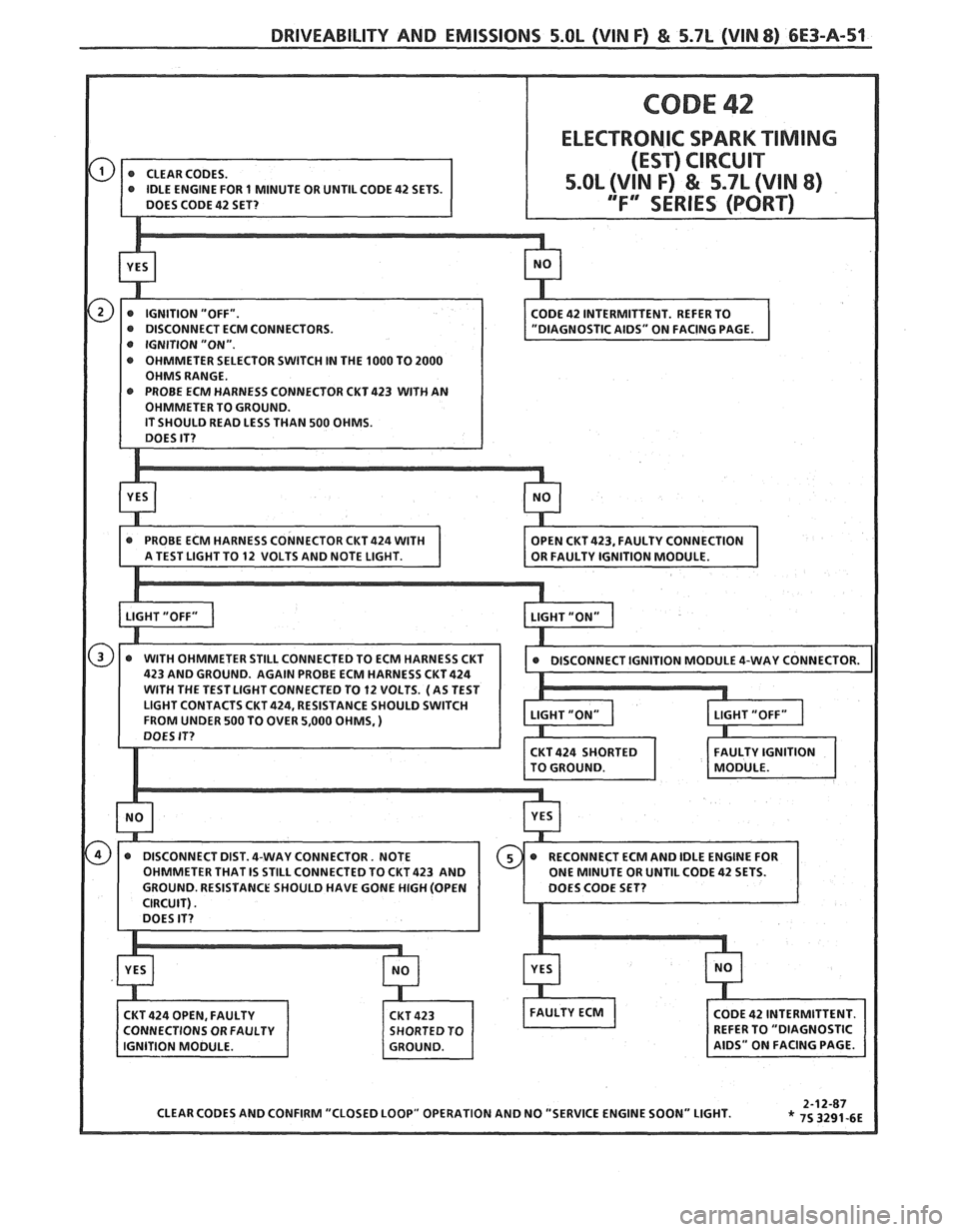
DRIVEABILITY AND EMISSIONS 5.OL (VIN F) & 5.7L (VIN 8) 6E3-A-51
ELECTRONIC SPARK TIMING
INUTE OR UNTIL CODE 42 SETS
@ PROBE ECM HARNESS CONNECTOR CKT 423 WITH AN
D READ LESS THAN 500 OHMS.
FROM UNDER 500 TO OVER 5,000 OHMS,
)
Page 855 of 1825
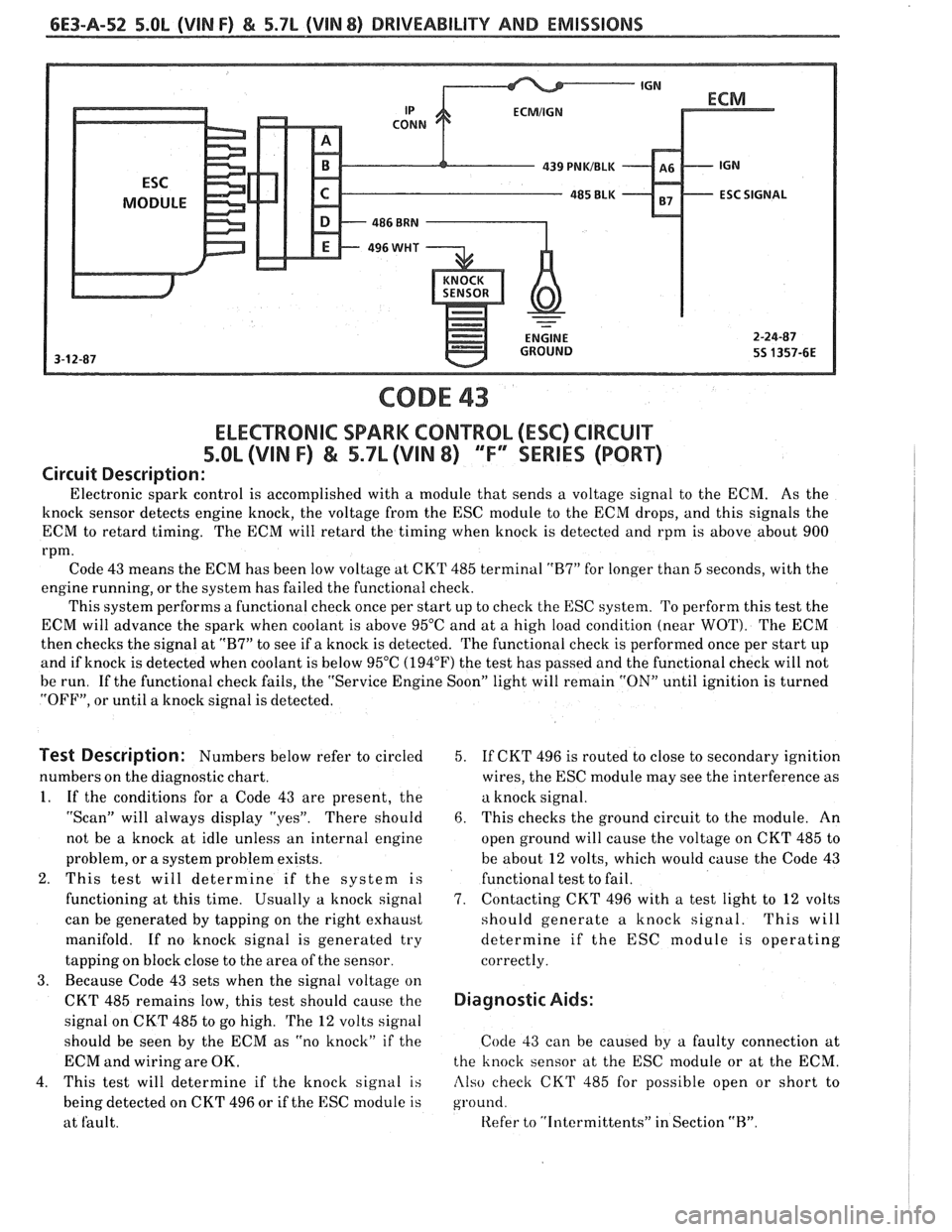
6E3-A-52 5.OL (VIN F) & 5.7L (VIN 8) DRIVEABILITY AND EMISSIONS
CODE 43
ELECTRONIC SPARK CONTROL (ESC) ClRCUlT
5.OL (VIN F) & 5.7L (VIN 8) 'TF" SERIES (PORT)
Circuit Description:
Electronic spark control is accomplished with a module that sends a voltage signal to the ECM. As the
knock sensor detects engine knock, the voltage from the ESC module to the ECM drops, and this signals the
ECM to retard timing. The ECM will retard the timing when knock is detected and rpm is above about 900
rpm.
Code 43 means the ECM has been low voltage at CKT 485 terminal
"R7" for longer than 5 seconds, with the
engine running, or the system has failed the functional check.
This system performs a functional check once per start up to check the
ESC system. To perform this test the
ECM will advance the spark when coolant is above 95°C and at a high load condition (near
WOT). The ECM
then checks the signal at
"B7" to see if a knock is detected. The functional check is performed once per start up
and if knock is detected when coolant is below 95°C
(194°F') the test has passed and the functional check will not
be run. If the functional check fails, the "Service Engine Soon" light will remain
"ON" until ignition is turned
"OFF", or until a knock signal is detected.
Test Description: Numbers below refer to circled
numbers on the diagnostic chart.
1. If the conditions for a Code 43 are present, the
"Scan" will always display "yes". There should
not be a knock at idle unless an internal engine
problem, or
a system problem exists.
2. This test will determine if the system is
functioning at this time. Usually
a knock signal
can be generated by tapping on the right exhaust
manifold. If no knock signal is generated try
tapping on block close to the area of the sensor.
3. Because Code 43 sets when the signal voltage on
CKT 485 remains low, this test should cause the
signal on CKT 485 to go high. The
12 volts signal
should be seen by the ECM as "no knock" if the
ECM and wiring are OK.
4. This test will determine if the knock signal
is
being detected on CKT 496 or if the ESC module is
at fault. 5.
If CKT
496 is routed to close to secondary ignition
wires, the ESC module may see the interference as
a knock signal.
6. This checks the ground circuit to the module. An
open ground will cause the voltage on CKT 485 to
be about
12 volts, which would cause the Code 43
functional test to fail.
7. Contacting CKT 496 with a test light to 12 volts
should generate a knock signal. This will
determine if the ESC module is operating
correctly.
Diagnostic Aids:
Code 33 can be caused by a faulty connection at
the knock sensor at the ESC module or at the ECM.
Also check CKT 485 for possible open or short to
ground.
Refer to "Intermittents" in Section "R".
Page 856 of 1825
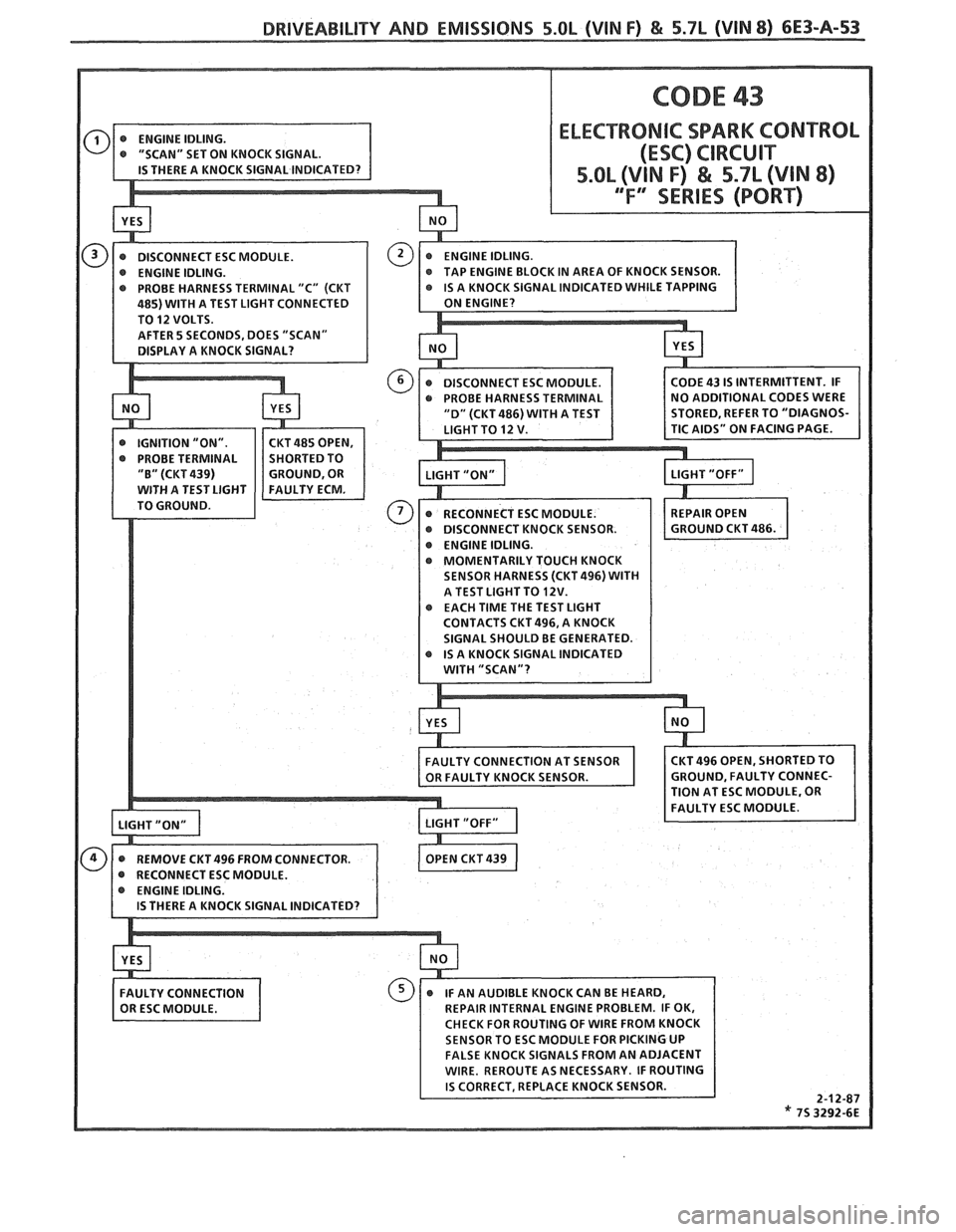
DRIVEABILITY AND EMISSIONS 5.OL (VIN F) & 5.7L (VIN 8) 6E3-A-53
ENGINE IDLING. LOCK
IN AREA OF KNOCK SENSOR.
PROBE HARNESS TERMINAL "C" (CKT GNAL
INDICATED WHILE TAPPING
485) WITH A TEST LIGHT CONNECTED
TO
12 VOLTS.
AFTER
5 SECONDS, DOES "SCAN"
r ENGINE IDLING.
@ MOMENTARILY TOUCH KNOCK
SENSOR HARNESS (CKT 496) WITH
A TEST LIGHT TO
12V. r EACH TIME THE TEST LIGHT
CONTACTS CKT
496, A KNOCK
SIGNAL SHOULD BE GENERATED.
Page 857 of 1825
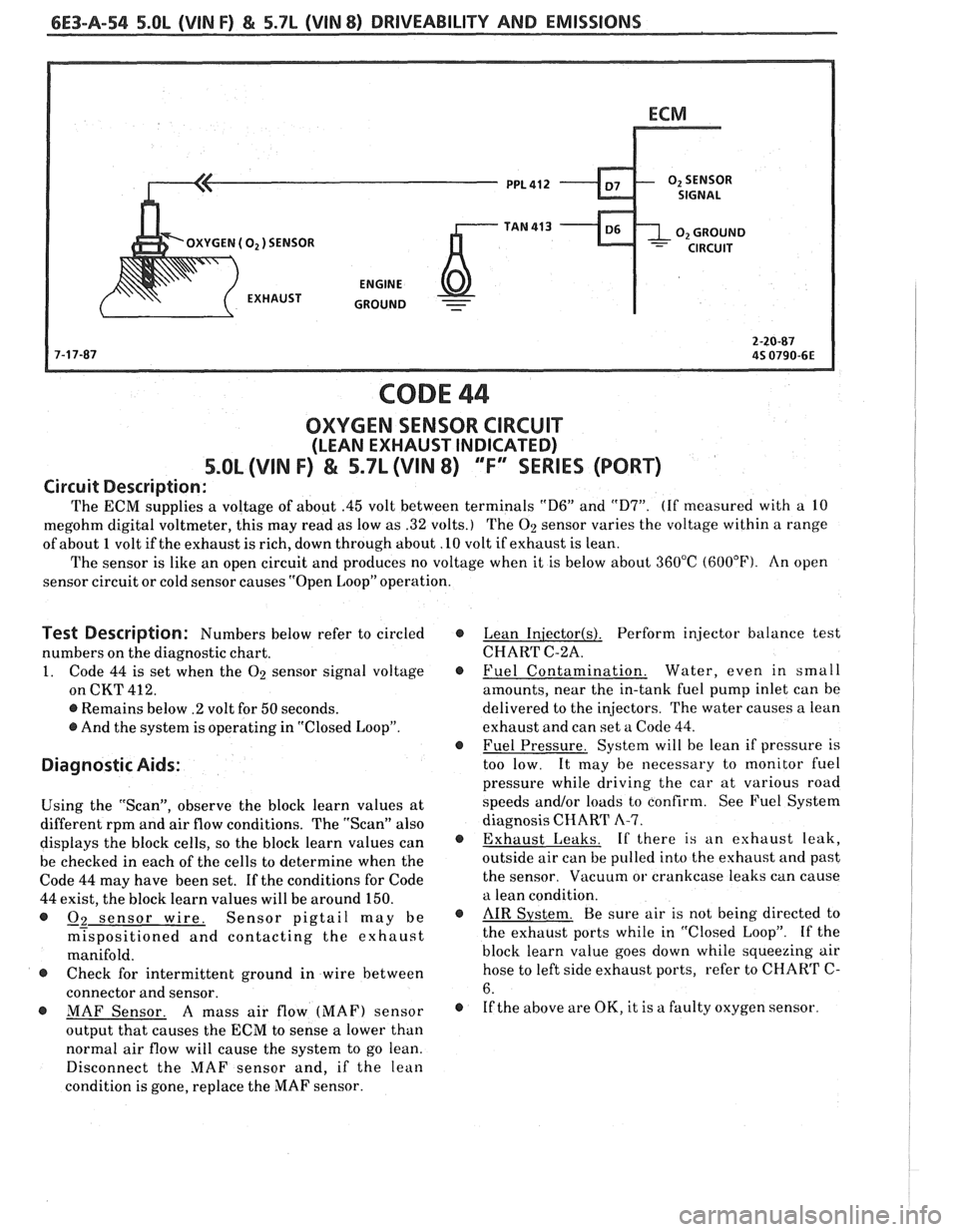
6E3-A-54 5.OL (VIN F) & 5.7L (VIN 8) DRIVEABILITY AND EMISSIONS
OXYGEN ( O2 ) SENSOR
CODE 44
OXYGEN SENSOR CIRCUIT
(LEAN EXHAUST INDICATED)
5.OL (VIN F) & 5.7L (VIN 8) '"F" "SERIES (PORT)
Circuit Description:
The ECM supplies a voltage of about .45 volt between terminals "D6" and "D7". (If measured with a 10
megohm digital voltmeter, this may read as low as .32 volts.) The
02 sensor varies the voltage within a range
of about 1 volt if the exhaust is rich, down through about .10 volt if exhaust is lean.
The sensor is like an open circuit and produces no voltage when it is below about 360°C
(600°F). An open
sensor circuit or cold sensor causes "Open Loop" operation.
Test Description: Numbers below refer to circled @
numbers on the diagnostic chart.
1. Code 44 is set when the O2 sensor signal voltage @
on CKT 412.
@ Remains below .2 volt for 50 seconds.
@ And the system is operating in "Closed Loop".
@
Diagnostic Aids:
Using the "Scan", observe the block learn values at
different rpm and air flow conditions. The "Scan" also
displays the block cells, so the block learn values can
@
be checked in each of the cells to determine when the
Code 44 may have been set.
If the conditions for Code
44 exist, the block learn values will be around 150.
@ - 02 sensor wire. Sensor pigtail may be @
m~spositioned and contacting the exhaust
manifold.
@ Check for intermittent ground in wire between
connector and sensor.
@ MAF Sensor. A mass air flow (MAF) sensor @
output that causes the ECM to sense a lower than
normal air flow will cause the system to go lean.
Disconnect the
MAF sensor and, if the lean
condition is gone, replace the
MAF sensor. Lean
Iniector(s). Perform
injector balance test
CHART C-2A.
Fuel Contamination. Water,
even in small
amounts, near the in-tank fuel pump inlet can be
delivered to the injectors. The water causes a lean
exhaust and can set a Code 44.
Fuel Pressure. System will be lean if pressure is
too low.
It may be necessary to monitor fuel
pressure while driving the car at various road
speeds
and/or loads to confirm. See Fuel System
diagnosis CHART
A-7.
Exhaust Leaks. If there is an exhaust leak,
outside air can be pulled into the exhaust and past
the sensor. Vacuum or crankcase leaks can cause
a lean condition.
AIR System. Be sure air is not being directed to
the exhaust ports while in "Closed Loop". If the
block learn value goes down while squeezing air
hose to left side exhaust ports, refer to CHART
C-
6.
If the above are
OK, it is a faulty oxygen sensor.
Page 858 of 1825
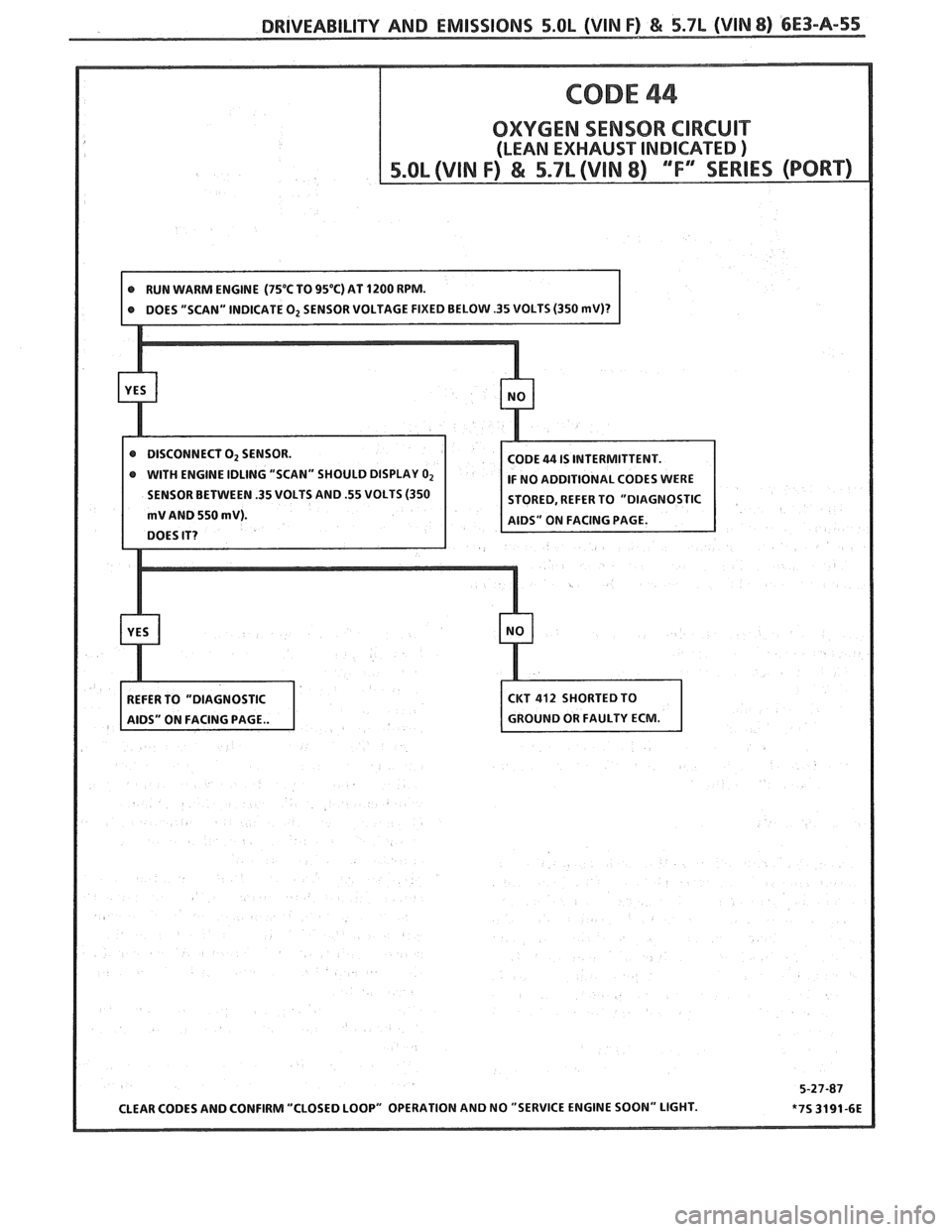
DRIVEABILITY AND EMISSIONS 5.OL (VIN F) & 5.7L (VIN 8) 6E3-A-55
IF NO ADDITIONAL CODES WERE
SENSOR BETWEEN .35 VOLTS AND .55 VOLTS (350
STORED, REFER TO "DIAGNOSTIC
mV AND 550 mV).
CLEAR CODES AND CONFIRM "CLOSED LOOP" OPERATION AND NO "SERVICE ENGINE SOON" LIGHT.
Page 859 of 1825
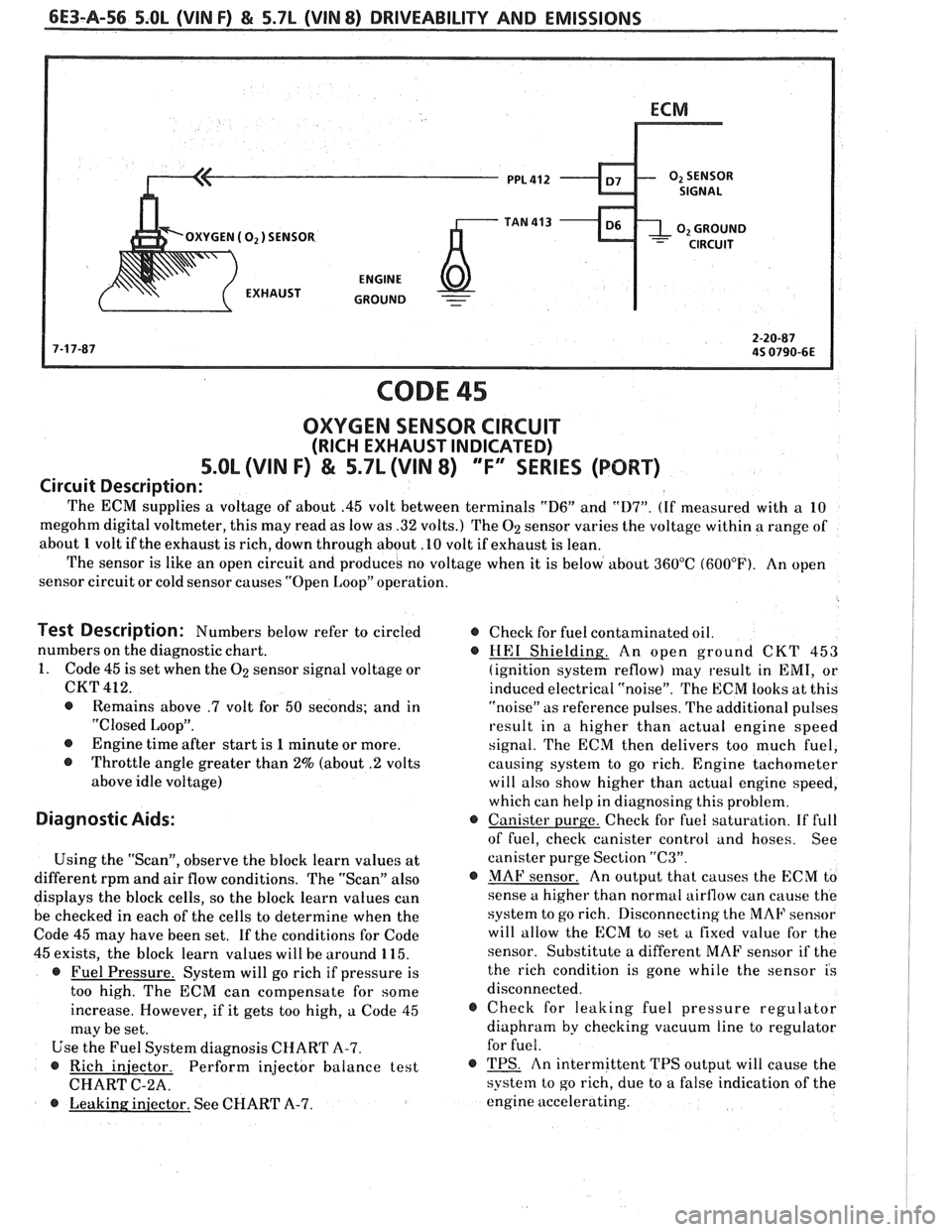
6E3-A-56 5.OL (VIN F) & 5.7L (VIN 8) DRIVEABILITY AND EMISSIONS
OXYGEN ( O2 )SENSOR
-
CODE 45
OXYGEN SENSOR CIRCUIT
(RICH EXHAUST INDICATED)
S.OL (VIN F) & 5.7L (VIN 8) ""F-ERIES (PORT)
Circuit Description:
The ECM supplies a voltage of about .45 volt between terminals "D6" and "D7". (If measured with a 10
megohm digital voltmeter, this may read as low as .32 volts.) The
02 sensor varies the voltage within a range of
about 1 volt if the exhaust is rich, down through about .10 volt if exhaust is lean.
The sensor is like an open circuit and produces no voltage when it is below about 360°C (600°F). An open
sensor circuit or cold sensor causes "Open Loop" operation.
Test Description: Numbers below refer to circled @ Check for fuel contaminated oil.
numbers on the diagnostic chart.
@ HE1 Shielding. An open ground CKT 453
1. Code 45 is set when the
02 sensor signal voltage or
(ignition system reflow) may result in EMI, or
CKT 412.
induced electrical "noise". The ECM looks at this
@ Remains above .7 volt for 50 seconds; and in
"noise" as reference pulses. The additional pulses
"Closed Loop".
result in a higher than actual engine speed
@ Engine time after start is 1 minute or more.
signal. The ECM then delivers too much fuel,
@ Throttle angle greater than 2% (about .2 volts
causing system to go rich. Engine tachometer
above idle voltage) will also show higher than actual engine speed,
which can help in diagnosing this problem.
Diagnostic Aids: @ Canister purge. Check for fuel saturation. If full
of fuel, check canister control and hoses. See
Using the "Scan", observe the block learn values at canister
purge Section
"C3".
different rpm and air flow conditions. The "Scan" also @ MAF sensor. An output that causes the ECM to
displays the block cells, so the block learn values can sense
a higher than normal airflow can cause the
be checked in each of the cells to determine when the system
to go rich. Disconnecting the MAF sensor
Code 45 may have been set. If the conditions for Code will
allow the ECM to set a fixed value for the
45 exists, the block learn values will be around 115. sensor.
Substitute a different MAF sensor if the
@ Fuel Pressure. System will go rich if pressure is the
rich condition is gone while the sensor is
too high. The ECM can compensate for some disconnected.
increase. However, if it gets too high, a Code 45
@ Check for leaking fuel pressure regulator
may be set. diaphram
by checking vacuum line to regulator
Use the Fuel System diagnosis CHART A-7. for
fuel.
@ Rich
iniector. Perform injector balance test @ TPS. An intermittent TPS output will cause the
CHART C-2A.
system to go rich, due to a false indication of the
@ Leaking injector. See CHART A-7. engine
accelerating.
Page 860 of 1825
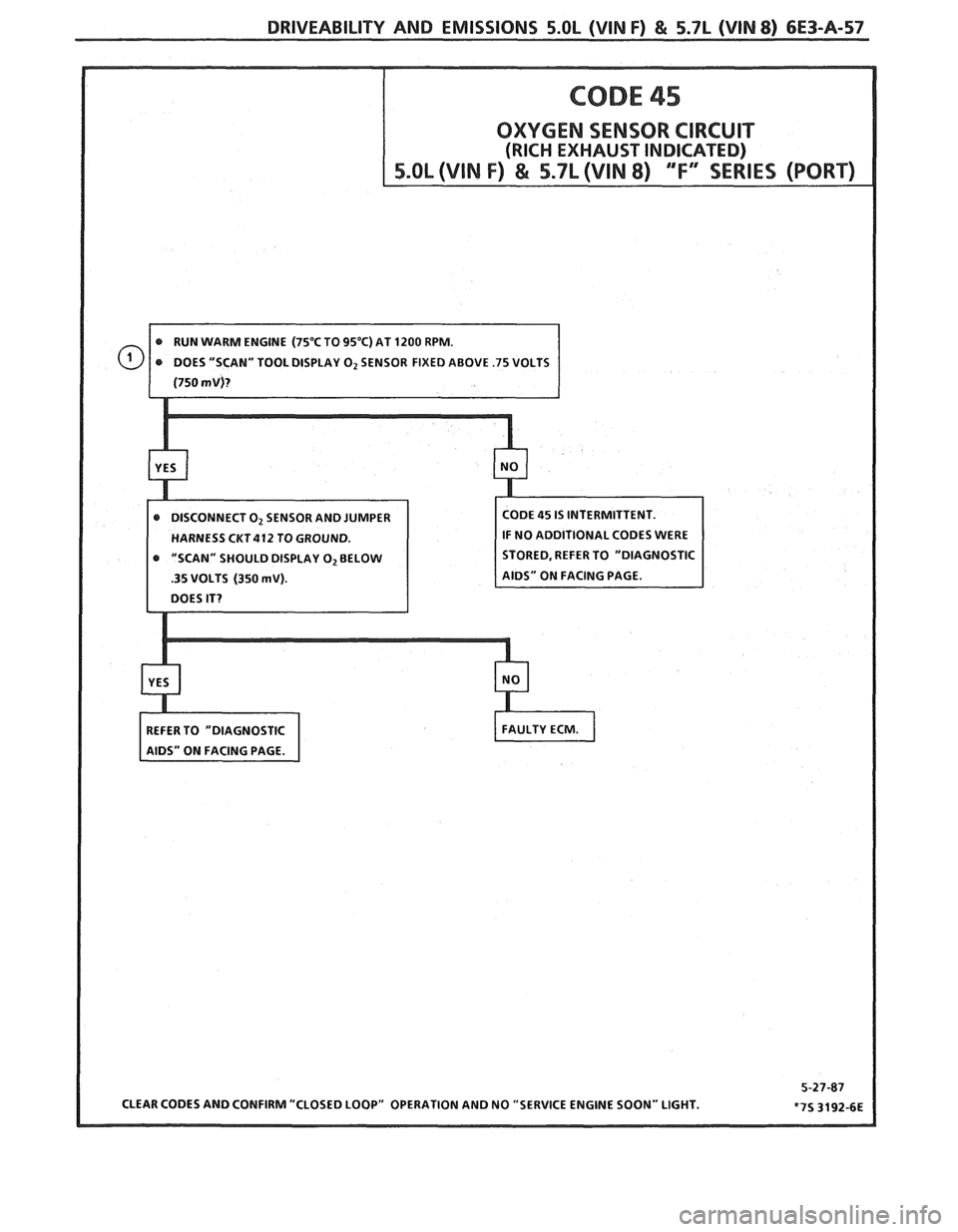
DRIVEABILITY AND EMISSIONS 5.OL (VIN IF) & 5.7L (VIN 8) 6E3-A-57
HARNESS CKT412 TO GROUND. NO
ADDITIONAL CODES WERE
.35 VOLTS (350 mV).
CLEAR CODES ANDCONFIRM "CLOSED LOOP" OPERATION AND NO "SERVICE ENGINE SOON" LIGHT.